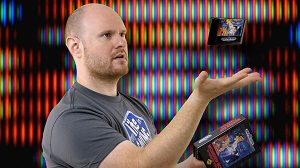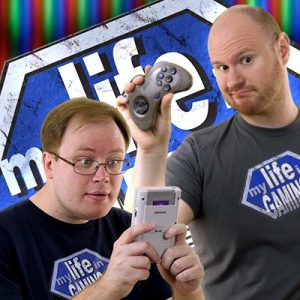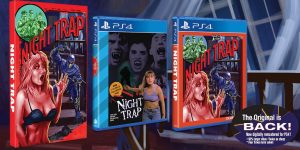 Anyone with a Sega CD has likely played Digital Pictures’ Night Trap. The continuous subject of controversy that even went all the way to the U.S. Senate, the game has as many supporters as it does detractors. That seems to be the way most people remember it; however, beneath the trappings of the full-motion video genre lies a story that’s fascinating. Night Trap’s development was a watershed moment for the video game industry, and the Limited Run Games recently released what should be considered the definitive version of the game for the PlayStation 4. Despite the supposedly bad reputation it has, the game sold out completely.
Anyone with a Sega CD has likely played Digital Pictures’ Night Trap. The continuous subject of controversy that even went all the way to the U.S. Senate, the game has as many supporters as it does detractors. That seems to be the way most people remember it; however, beneath the trappings of the full-motion video genre lies a story that’s fascinating. Night Trap’s development was a watershed moment for the video game industry, and the Limited Run Games recently released what should be considered the definitive version of the game for the PlayStation 4. Despite the supposedly bad reputation it has, the game sold out completely.
Yes, a quarter-century after its initial release, Night Trap is still selling. The YouTube channel My Life in Gaming recently shot a remarkable documentary that chronicles the game’s development. It includes an interview with James Riley, its main designer, and it takes viewers through the entire process of how Night Trap came to be. An abridged version is also included in the Limited Run Games release, and the full documentary is available by them as a Blu-Ray disc.
We had the opportunity to chat with Coury Carlson, the co-host of My Life in Gaming, and one of the co-creators of the documentary (along with Marc Duddleson). He shed some light on the process of tackling the story of one of gaming’s most infamous titles.
Sega-16: Give us a bit of background about yourself. How long have you been making videos?
Coury Carlson: I’ve worked in video, mainly post production since 2004 – Freelancing and then working at a post house in NYC for seven years. My Life in Gaming (MLiG) started a way for myself and Marc Duddleson (Try), who also works in production in North Carolina, to make videos about stuff that we were really passionate about. We had spent a lot of time figuring out how we could create the best possible setup getting perfect quality from our games.
 We launched our first video on October 1st, 2013. It was a video that was based on the old How to Win VHS tapes that were a bit of an oddity even in the ’80s. These tapes, especially the ones put out by Game Players magazine had a big effect on me. We took the quirkiness of those videos and applied them to modern games. We still get a laugh out of how we spent all this time making this pristine capture setup only to lay that HD footage off to VHS tape to make it look as bad and authentic as possible.
We launched our first video on October 1st, 2013. It was a video that was based on the old How to Win VHS tapes that were a bit of an oddity even in the ’80s. These tapes, especially the ones put out by Game Players magazine had a big effect on me. We took the quirkiness of those videos and applied them to modern games. We still get a laugh out of how we spent all this time making this pristine capture setup only to lay that HD footage off to VHS tape to make it look as bad and authentic as possible.
The channel evolved slowly into what it is today. While its mainly a tech channel focused on retro gaming technology, we mainly just want to talk about things that we think are cool. Some subjects are naturally more popular than others, but it’s important for us to not lose our vision of what we want the channel to be.
Sega-16: Your work on “My Life in Gaming” has been great over the years, with incredible production values and detailed explanations of different gaming concepts. Take us through your typical video-making process. How long does it take for you to complete an episode?
Coury Carlson: Since Try and I don’t live close to each other (around 7.5 hours’ drive on a good day) our episodes are pretty much “our own.” What I mean by that is that we handle pretty much every aspect of the episode we are editing. If we both appear in the episode, the person not editing usually provides their on-camera materials and that’s about it.
How much work an episode takes really depends on the subject. Episodes in the RGB Master Class series take by far the longest. From the scripting, which is fact checked by upwards of five people, to shooting and editing, I’d say that an average episode takes 40-60 hours from start to finish. Some longer.
Game or series showcases take a much shorter amount of time – around 10-20 hours depending on the amount of things covered. The showcases are often viewed as “taking a break” when we need to do something that isn’t so technical and can exist on mainly gameplay footage alone.
Sega-16: Are you a fan of full-motion video (FMV) games? They’ve historically been panned by many gamers, but they seem to have developed something of a cult following over the years.
Coury Carlson: I’m a big FMV fan, actually. The Sega CD released when I was 13 years-old and I feel like that was a great age to be when they were more prominent. Night Trap came out a time when I was really starting to figure out about late night HBO and Cinemax. And that doesn’t even mention stuff like Road Avenger (which has maybe the best intro song of all time) and Time Gal.
I was all about FMV stuff, until Lunar came out and Working Designs changed games for me.
Sega-16: How did you get involved with this project? Was it something you pitched, or was it brought to your attention by another source?
Coury Carlson: How this whole project came together is really crazy. It’s one of my favorite stories to tell because it was honestly like winning the lottery. I’ll try to make it as brief as possible.
Back in 2012, I met a guy named Dave Voyles at Barcade in Brooklyn over a game of Final Fight. We became fast friends when I said that my favorite version was the Sega CD one. He was learning to code and after landing a job at Microsoft, he would do different projects to keep himself “sharp.” One of those projects was converting Night Trap to HTML5 which got a little bit of attention and he was brought into the Night Trap community made up of a lot of people who worked on or acted in the game.
Fast forward to January of 2016. MLiG was doing decently, and I had left New York City and moved with my wife and kids to Newport, Kentucky – right across the Ohio river from Cincinnati. We had begun doing a weekly livestream (Sunday nights, 9-11PM Eastern) as a way to interact with our audience. One stream we played Night Trap and had Dave on as a guest with us via Skype to talk about the game. In that chat room there was a guy, Tyler Hogle, who Dave knew from the Night Trap community and was currently porting a couple of Digital Pictures games to mobile, Double Switch and Quarterback Attack.
Through a series of remarks and mentions that Tyler made throughout the stream, we’d eventually figure out that Tyler lived DOWN THE STREET from me. Like, less than five minutes away. He invited me over to show me the Double Switch build he was working on – a few months later he said that he had licensed Night Trap and was going to bring it to mobile… then it went to PC… then to consoles. He wanted us to produce some stuff on the game, because he liked what we had done on the channel. I would be crazy to pass up an opportunity like this and since I was a fan and had history with the game it made even more sense.
So really, it was like winning the lottery. A random meeting at a game of Final Fight in Barcade Brooklyn led to this project over five years later. Out of all of the places I could have moved when my family and I had left NYC this is where we ended up. It’s all pretty surreal.
 Sega-16: Was this project different in any way from previous episodes of “My Life in Gaming,” given the subject matter?
Sega-16: Was this project different in any way from previous episodes of “My Life in Gaming,” given the subject matter?
Coury Carlson: Well, this style of documentary is something we wanted to do since we first started the channel, but we knew we had to build up a body of work first before people would take us seriously and we’d have these opportunities. So, we always tried to make the most family friendly, well edited and shot videos that we could so that when it came time to pitch stuff people would trust us.
We had done a small, sub-10-minute mini documentary on HD Retrovision that created these great component cables for 16-bit consoles. When Try was going to be on vacation up near Seattle, he used that video and some others to pitch an interview with Rand Miller, co-creator of Myst, who was working on the Kickstarted title Obduction. Them saying yes was really a big break and a huge vote of confidence in what we could do. The doc on Limited Run Games was a further evolution.
So really, we might be mainly known as “the video quality” guys but these types of episodes are something we’ve been planning on for a long time. Now that we have several big ones under our belt I feel like more opportunities will pop up. We want to have them become a major pillar of our channel.
Sega-16: Did you get to see any previously-unseen documentation or footage of the game while filming?
Coury Carlson: Well a lot of the unseen stuff we had access to made it into the doc. James Riley gave us some cool material, like the story boards and BTS images, but obviously Scene of the Crime was the mother lode. It was so cool to finally be able to see this footage that Hasbro execs were watching in that room in the hidden video in Night Trap.
For me, just seeing the full resolution footage was incredible. If i could have told my 13-year-old self that it was what I’d be doing 25 years later, there is no way I’d ever believe it. The hardest part about this was not being able to tell anyone what we were working on!
Sega-16: Were there any members of the original development team you wanted to interview but couldn’t?
Coury Carlson: We tried to get as many people as we could. We tried for several actors and Tom Zito, mainly. We never heard back from anyone.
According to Jim Riley, Tom was close but couldn’t make it at the last minute – of course we only heard this through him. Tom never responded to my direct email. In my personal opinion, I think that it came down to the fact that based up on Night Trap’s reputation, he thought it was going to be another drubbing of the game, when our intentions were anything but.
In terms of the actors, I get the impression that a lot of the actors who portrayed the girls have been regularly hounded via social media over the years. We contacted one woman who we thought may have played Ashley in the game. She said that it wasn’t her but had been contacted by a film student years ago and after telling him that he had the wrong person, he wouldn’t leave her alone for weeks and to stop lying to him about not being who he thought she was. I’m sure the other actors have experienced this enough to just not respond to anything anymore.
Although I wish we could have had these people involved, I think it’s a real testament to how strong of an interviewee James Riley was. He carries the whole on his shoulders, and spending time with him was just awesome. He made the whole thing work.
Sega-16: What did you learn, as a filmmaker, from this project? Were there any lessons you took away from the experience?
Coury Carlson: We learned a ton on this project but the big thing was that we should be confident in doing this kind of material. When it comes to traveling as a team, getting the right material, having it look good. I feel very confident that we can take on even larger scale docs in the future.
Sega-16: After watching the episode, I’ve gained a greater appreciation for Night Trap’s place in history. What message do you hope viewers take from watching the episode?
 Coury Carlson: Well, you know, I think that the reaction you had to watching the episode is exactly what we wanted from it. Everyone thinks of Night Trap as only this cheesy and bad FMV game that had a lot of controversy around it. Out of the 49-minute run-time, only about 6 of that is spent on the congressional hearings and I’m really proud of that. It’s important, sure, but when it comes to NT, most people already know all about that. We really wanted to put the focus on how the game was made and the life it lived to end up where it did. How did the people involved figure out how to make this game?
Coury Carlson: Well, you know, I think that the reaction you had to watching the episode is exactly what we wanted from it. Everyone thinks of Night Trap as only this cheesy and bad FMV game that had a lot of controversy around it. Out of the 49-minute run-time, only about 6 of that is spent on the congressional hearings and I’m really proud of that. It’s important, sure, but when it comes to NT, most people already know all about that. We really wanted to put the focus on how the game was made and the life it lived to end up where it did. How did the people involved figure out how to make this game?
We’ve had a lot of people say in the comments of the video is that “before I watched this, I never thought of Night Trap as anything more than a crappy joke of a game, and now I really appreciate the work that went into it.”
Sega-16: Are there any other Sega titles you’re considering featuring in a future episode?
Coury Carlson: Well, I always have a lot of plans for Sega stuff, it’s just a matter of finding the opportunities. I’m currently working what will become a multi part series focusing on the Sega Ages 2500 series of games. I was originally going to do 11 games across three episodes, but that ended up being too much. So, I whittled it down to five episodes of between five and six games per.
On the tech side, of course Game Gear and Dreamcast RGB episodes are in the pipeline, but I’ll probably be doing an episode focusing on the GD Emu and Phoebe/Rhea SD Card drive replacement mods for the Dreamcast and Saturn.
On the doc side, we have two that we are hoping will come together that we are talking to people about. Both are absolute dream projects for me especially, with one of those involving time spent in Japan. I’d love to tell you what they are but I don’t want to jinx it. I think both will be very exciting for Sega fans.
Our thanks to Coury for taking the time for this interview. For more information on My Life in Gaming, check out their YouTube channel. Night Trap was funded by My Life in Gaming and it supporters on Patreon. If you like what they do and want to see them produce bigger and better documentaries and deep dives into console hardware, please check it out. You can follow them on Twitter at @mylifeingaming, @CouryC, @Tryump4ks. Episode notes and other stuff is available on their website.

Recent Comments